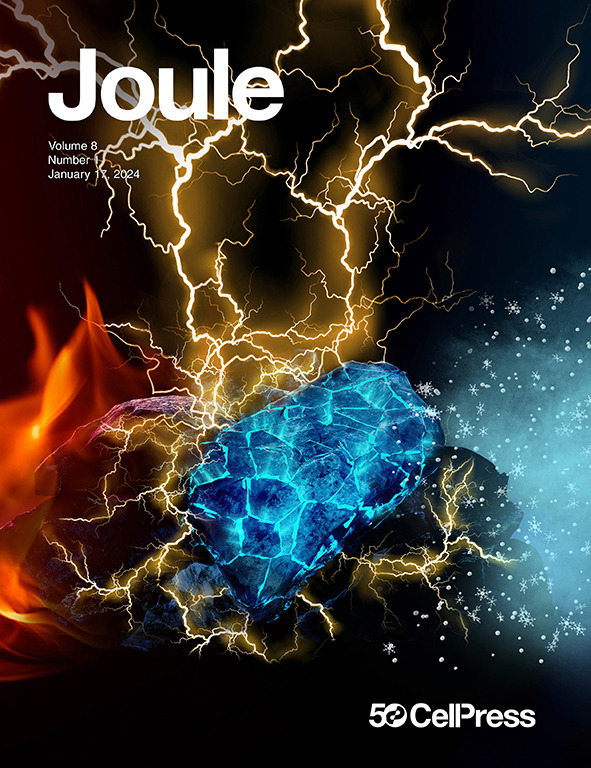Sodium-air fuel cell for high energy density and low-cost electric power
IF 35.4
1区 材料科学
Q1 CHEMISTRY, PHYSICAL
引用次数: 0
Abstract
Alkali metal-air batteries have exceptional theoretical energy densities but suffer from poor rechargeability and low power largely due to the formation of solid discharge products. An alternative concept demonstrated here is a liquid sodium metal-air fuel cell incorporating a solid electrolyte membrane, wherein controlled humidification of the air stream continuously removes sodium hydroxide discharge product as a deliquesced liquid. This fuel cell reaches stack-level energy densities of 1,200 Wh/kg (1,295 Wh/L) at 80 mA/cm2 and 1,540 Wh/kg (1,760 Wh/L) at 40 mA/cm2 current density, while consuming up to 2.3-cm thickness of sodium metal (2,500 mAh/cm2 areal capacity) in continuous operation. The sodium hydroxide discharge product also readily captures ambient CO2. Combined with the high planetary abundance and low cost of sodium, the sodium-air fuel cell may be a more sustainable power source for hard-to-decarbonize transportation and stationary electrical power applications.


钠-空气燃料电池的高能量密度和低成本的电力
碱金属-空气电池具有优异的理论能量密度,但由于固体放电产物的形成,其可充电性差,功率低。这里展示的另一个概念是包含固体电解质膜的液态钠金属-空气燃料电池,其中控制气流的加湿连续去除氢氧化钠排放产物作为潮解液体。这种燃料电池在80 mA/cm2电流密度下达到1200 Wh/kg (1295 Wh/L),在40 mA/cm2电流密度下达到1540 Wh/kg (1760 Wh/L),同时在连续运行中消耗高达2.3 cm厚度的金属钠(2500 mAh/cm2面积容量)。氢氧化钠排放产物也容易捕获周围的二氧化碳。结合钠的高行星丰度和低成本,钠-空气燃料电池可能是一种更可持续的能源,用于难以脱碳的运输和固定电力应用。
本文章由计算机程序翻译,如有差异,请以英文原文为准。
求助全文
约1分钟内获得全文
求助全文
来源期刊

Joule
Energy-General Energy
CiteScore
53.10
自引率
2.00%
发文量
198
期刊介绍:
Joule is a sister journal to Cell that focuses on research, analysis, and ideas related to sustainable energy. It aims to address the global challenge of the need for more sustainable energy solutions. Joule is a forward-looking journal that bridges disciplines and scales of energy research. It connects researchers and analysts working on scientific, technical, economic, policy, and social challenges related to sustainable energy. The journal covers a wide range of energy research, from fundamental laboratory studies on energy conversion and storage to global-level analysis. Joule aims to highlight and amplify the implications, challenges, and opportunities of novel energy research for different groups in the field.
 求助内容:
求助内容: 应助结果提醒方式:
应助结果提醒方式:


